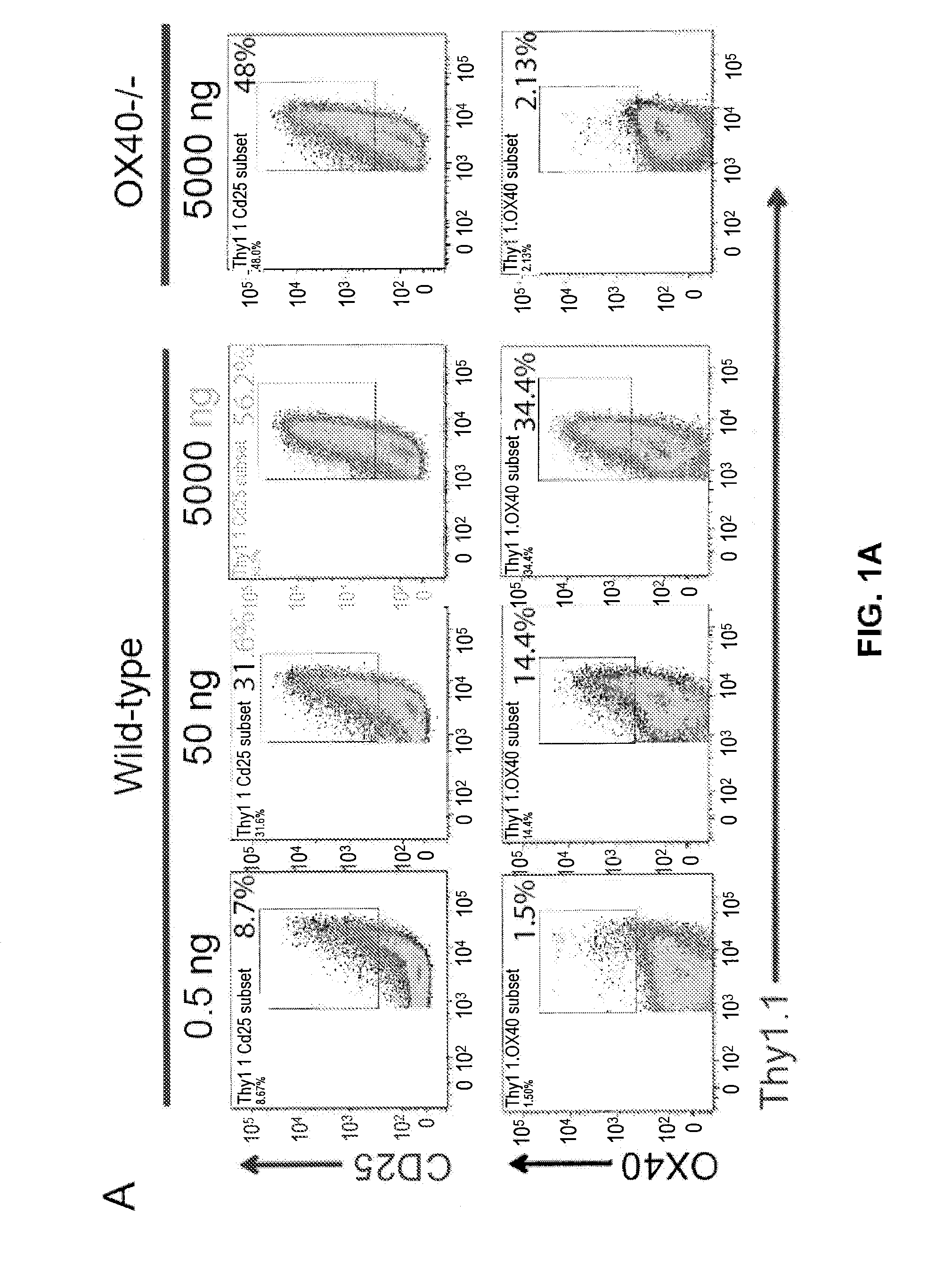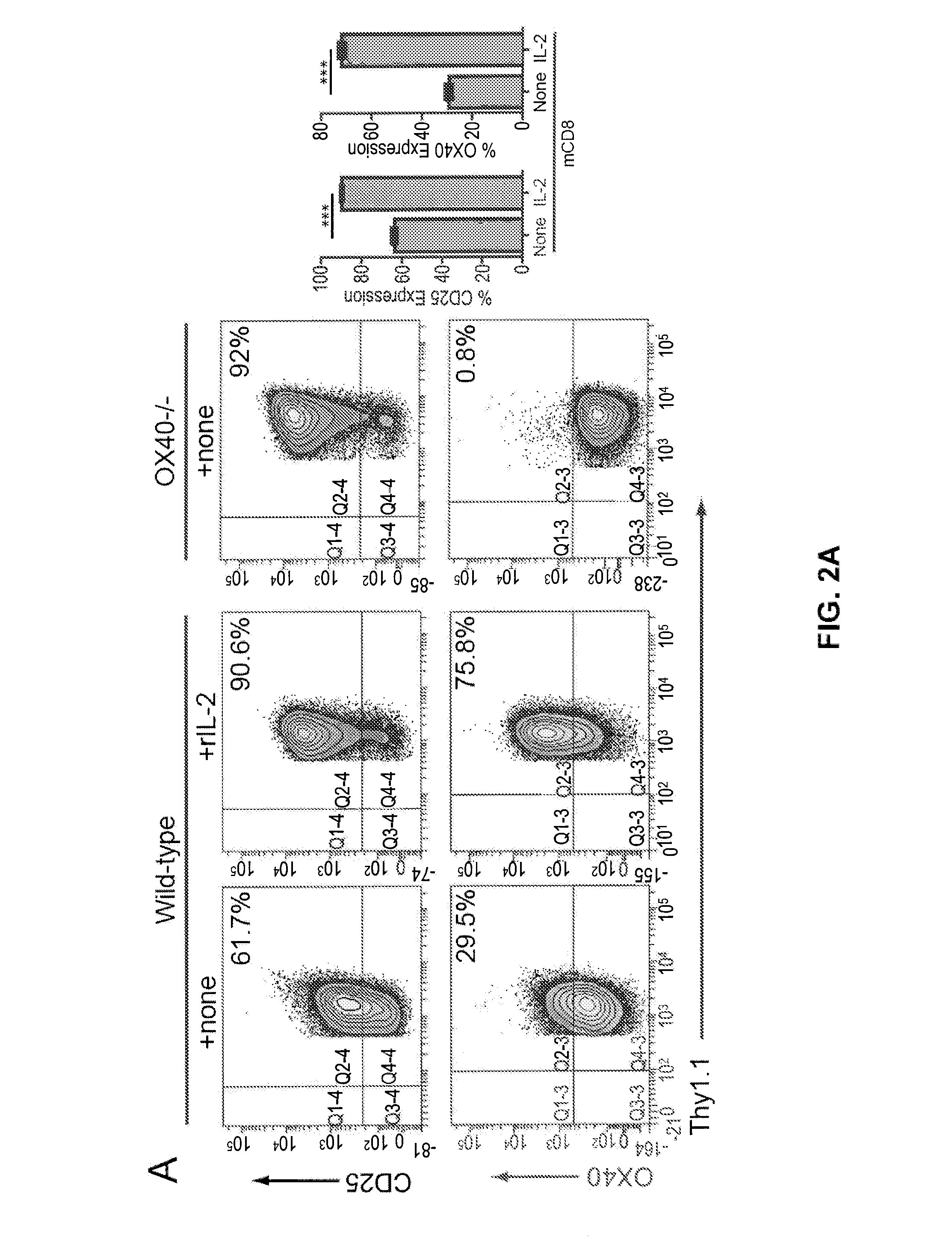Dual ox40 agonist/il-2 cancer therapy methods
a cancer therapy and agonist technology, applied in the field of dual ox40 agonist/il2 cancer therapy methods, can solve the problem that the study did not address directly whether il-2r signaling affects ox40 expression, and achieve the effects of stabilizing disease in patients, prolonging patient's survival, and reducing growth
- Summary
- Abstract
- Description
- Claims
- Application Information
AI Technical Summary
Benefits of technology
Problems solved by technology
Method used
Image
Examples
example 1
Optimal OX40 Expression is Regulated by the Strength of TCR Stimulation and IL-2Rα (CD25)
[0101]The extent to which the strength of TCR stimulation affects OX40 expression, the kinetics of OX40 up-regulation following the activation of naïve CD8 T cells was assessed as follows. Purified naïve wild-type or OX40− / − OT-I T cells (2×105 / ml) were activated with syngeneic antigen presenting cells (APCs) (2×103 / ml) pulsed with increasing doses (0.5 ng, 50 ng, or 5000 ng) of the OVA peptide, SIINFEKL. One to three days later, activated OT-I T cells were harvested and the expression of OX40 and CD25 was determined by flow cytometry. CD25 was rapidly up-regulated and reached maximal expression within 24 hrs after TCR stimulation at the highest dose of Ag (5000 ng / ml) whether or not OX40 was expressed (FIG. 1A, 1B). Maximal OX40 expression was similarly induced in a dose-dependent manner with peak OX40 expression observed 3 days post-stimulation in the OX40-expressing cells (FIG. 1A, 1B). The b...
example 2
Exogenous IL-2 Up-Regulates OX40 on Activated Murine and Human T Cells
[0104]Whether the addition of exogenous rIL-2 was sufficient to up-regulate OX40 on activated T cells was determined as follows. Purified naïve wild-type or OX40− / − OT-I T cells (1×106 / ml) were activated with cognate peptide-pulsed syngeneic splenocytes (6×106 / ml). Two days later, activated OT-I T cells were harvested and re-cultured (5×105 cells / nil) in the presence or absence of recombinant murine IL-2 (100 ng / ml). The extent of CD25 and OX40 expression was determined by flow cytometry. The addition of exogenous rIL-2 led to a statistically significant increase in both CD25 and OX40 expression compared to media alone (FIG. 2A), demonstrating that IL-2 signaling was sufficient to drive up-regulation of these molecules on activated murine T cells.
[0105]Whether TCR stimulation plus exogenous rIL-2 similarly regulated OX40 expression on human T cells was examined as follows. Purified human CD8+ or CD4+ T cells were ...
example 3
OX40 Expression is Regulated by JAK3, STAT5, and STAT5
[0107]The tyrosine kinase JAK3 binds to the common γc subunit and its phosphorylation is a critical factor in the proximal downstream signaling following stimulation with γc cytokines (Kovanen P E, and Leonard W J. Immunol Rev 2004; 202: 67-83; Rochman Y, et al. Nat Rev Immunol 2009; 9: 480-90). Whether JAK3 activation is required to induce OX40 expression was examined as follows. First, the expression of JAK proteins in CD8+ T cells stimulated in vitro was assessed. Antigen-specific CD8+ T cells from OT-1 transgenic mice (as in Examples 1 and 2) were used for these studies in order to control more precisely the extent and duration of TCR stimulation. Naïve wild-type or OX40− / − OT-I T cells were activated for two days with peptide-pulsed APCs as described above. The activated OT-I T cells were then harvested and re-cultured (5×105 cells / ml) with media or recombinant murine IL-2 (100 ng / ml), and the expression of phosphorylated JA...
PUM
| Property | Measurement | Unit |
|---|---|---|
| time | aaaaa | aaaaa |
| time | aaaaa | aaaaa |
| area | aaaaa | aaaaa |
Abstract
Description
Claims
Application Information
 Login to View More
Login to View More - R&D
- Intellectual Property
- Life Sciences
- Materials
- Tech Scout
- Unparalleled Data Quality
- Higher Quality Content
- 60% Fewer Hallucinations
Browse by: Latest US Patents, China's latest patents, Technical Efficacy Thesaurus, Application Domain, Technology Topic, Popular Technical Reports.
© 2025 PatSnap. All rights reserved.Legal|Privacy policy|Modern Slavery Act Transparency Statement|Sitemap|About US| Contact US: help@patsnap.com



